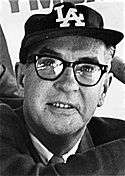Lemoine Blanchard

in 1964
C. Lemoine Blanchard (1910–86) was a businessman who was a member of the Los Angeles City Council from 1959 until 1963 and a board member of the national YMCA..
Biography
Blanchard was born on October 16, 1910, the son of Mr. and Mrs. Roscoe W. Blanchard, Sr. He was brought to the San Fernando Valley when he was a year old, was educated locally and, after graduating from high school, he joined his father's North Hollywood firm, Blanchard Lumber Company, of which he later became owner. He was a "lifelong supporter" of the East Valley YMCA and president of the North Hollywood Kiwanis and the Al Malaikah Shrine Temple.[1][2] In 1967 he was named to the national board of the YMCA.[3]
He died August 13, 1986, in North Hollywood. He was survived by his wife, Frances; two children, Carol Sanders and Ross Lemoine Blanchard; a brother, Roscoe W. Blanchard, Jr., and two sisters, Dorothy Camp and Maude Humm. Funeral services were held in the First Christian Church of North Hollywood.[2]
Public life
Los Angeles County
Blanchard was a member of the Los Angeles County Housing Authority for fifteen years until elected to the city council in 1959.[1]
City Council
Elections
See also List of Los Angeles municipal election returns, 1959–63.
In the 1950s, Los Angeles City Council District 2 covered Hollywood and a "sizable portion" of the San Fernando Valley, generally west of Ventura Boulevard and extending north to Encino.[4]
Blanchard ran for election there in 1959, and he ousted incumbent Earle D. Baker in the final vote. The next year, the 2nd District was divested of its Hollywood area, which was instead attached to the 13th District. Blanchard was defeated for reelection in 1963 by challenger James B. Potter, Jr.: Mayor Sam Yorty supported Potter and opposed Blanchard.[5][5][6]
Highlights
Blanchard was described as an "arch-foe" of Mayor Sam Yorty.[7] Some highlights of Blanchard's term on the City Council:
Zoo, 1959. He voted in favor of a contract with a nonprofit organization called Friends of the Zoo to operate a "Los Angeles world zoo" for fifty years, at the end of which time the Friends would turn it over to the city.[8]
Monorail, 1962. Blanchard urged the city council to recognize "in principle" the concept of monorail to serve Los Angeles. He had just returned from a visit to Seattle, Washington, to inspect the Alweg Seattle Center Monorail system there. He suggested appointment of "an outstanding Los Angeles civic leader" to serve as a negotiator in the council's dealings with the Metropolitan Transit Authority.[9]
Housing, 1962. He called on the council to oppose a state ballot proposition that would give the city Housing Authority permission to build homes for the aged and physically handicapped. He described it as "another scheme to establish state-financed public housing in California."[10]
Control, 1962. He proposed a plan to eliminate citizens commissions that had control over municipal departments, thereby increasing the power of the city council at the expense of the mayor, who appointed the commission members.[11]
Congress
Blanchard was the Republican candidate for the U.S. Congress in November 1960. He lost by a slight margin to fellow councilman James C. Corman, a Democrat, 48.9% to 51.1%.[12]
Airport Commission
In an "anti-Yorty act," Blanchard was appointed to the Los Angeles Airport Commission by City Council President L.E. Timberlake. who was acting mayor while Mayor Yorty was out of town on a European trip. The council confirmed the appointment by a 9-6 vote, leaving the mayor "furious" and promising to stop the appointment on his return.[7] The action, however, was ruled legal by City Attorney Roger Arnebergh.[13]
References
Access to the Los Angeles Times links may require the use of a library card.
- 1 2 "Lemoine Blanchard 2nd District," El Pueblo, August 25, 1961, in Los Angeles Public Library reference file
- 1 2 "Funeral Announcements," Los Angeles Times, August 15, 1986, page 2
- ↑ "Ex-Councilman Honored by National Y," Los Angeles Times, December 24, 1967, page 6
- ↑ "Council Contests in Seven Districts," Los Angeles Times, April 3, 1955, page B-1
- 1 2 "The City Elections," Los Angeles Times, April 7, 1963, page 5
- ↑ "Redistrict Ordinance Now Law," Los Angeles Times, November 15, 1960, page 1
- 1 2 "Blanchard Put on Airport Board by 9-6 Council Vote," Los Angeles Times, September 17, 1963, page A-1
- ↑ "Zoo Pact Approved by Council," Los Angeles Times, November 10, 1959, page 1
- ↑ Ray Hebert, "Monorail Plan Urged in Council," Los Angeles Times, April 11, 1962, page 1
- ↑ "Councilman Seeks Defeat of Housing Plan," Los Angeles Times, May 1, 1962, page A-2
- ↑ "Plan to Curb City Boards Under Study," Los Angeles Times, September 16, 1962, page F-3
- ↑ JoinCalifornis.com
- ↑ "Blanchard's Airport Job Upheld by City Attorney," Los Angeles Times, September 18, 1963, page A-1
| Preceded by Earle D. Baker |
Los Angeles City Council 2nd District 1959–63 |
Succeeded by James B. Potter, Jr. |